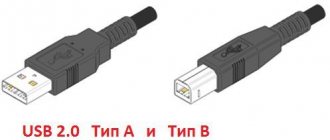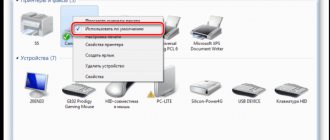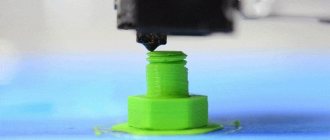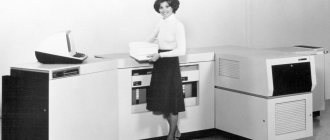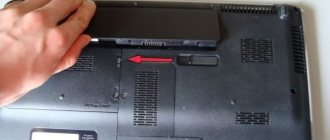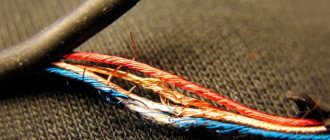For certain reasons, sometimes the printer does not print only black or does not output a specific color shade. If it is said that a certain color is missing on the used sheet, but the printing itself works, then it is most likely that the reason lies in consumables (cartridges, ink). But systemic failures should not be ruled out. Poor printer output with no colors can happen on a device from absolutely any manufacturer (HP, Canon, Epson, Brother and others). Why this happens and what can be done for each specific case is described below.
Physical problems
Checking the connection
The quality of the connection of the power cable and the cord connecting the printing device to the computer is immediately checked. The corresponding button on the body of the first one must be turned on. If the connection is made via Wi-Fi, the signal level is checked. The lights on the printer should be lit to indicate that it is ready for use.
The reason is paper
The paper may not be properly secured in the tray, or there may be paper jams inside the printer. Such problems need to be eliminated. Also check whether the paper meets the specifications of your printer model. The optimal paper density for the printer is 80 g/sq.m.
Do not use damaged or previously used sheets.
Check that you have loaded the paper the correct way into the tray. Photo paper and envelopes have a printable side, but a non-printable back side.
Clogged or dry cartridges or print head
With intensive and frequent printing without preventive maintenance, the ink passage channels in the middle of the cartridge or print head become clogged with ink, and dust or foreign matter from a low-quality consumable can also get into them. If you rarely print on the printer, the ink may dry out on different surfaces of the device. Sometimes, for any reason, the printer does not print not only with black ink, but also with color.
Cleaning can be physical or software. In the first case, user intervention is required to wash the equipment and remove any remaining ink. The second uses utilities or standard software from the manufacturer, which includes a head cleaning function.
The supply channel is cleaned as follows:
- Go to the printer settings and in the “Approximate ink levels” section, check the amount of dyes in the containers.
- Print a test sheet to make sure washing is necessary.
- Remove the print head and wash it with a special liquid. Typically, printer manufacturers produce liquids themselves; for example, HP offers formulations based on sodium sulfoethosylate and isopropylene alcohol. Article about flushing fluids for cartridges.
- The effect of the product begins 10-20 minutes after application.
- Wipe the head, dry it and put it back in its original place.
- Go to the print device settings and in the “Print head cleaning” section, select “Enhanced cleaning” and click on “Start”.
- To check the result, print a test page again.
- Repeat washing if necessary.
Cleaning cartridges must be done one at a time.
An ink tank removed from the printer should not be left outside its permanent location for more than 30 minutes.
Incorrect cartridge refilling
- Poor quality paint. Bad ink can be refilled in both black and color cartridges. Paints can only be purchased from an official manufacturer or a reliable supplier.
- Inappropriate dye. If the device refuses to print, but there is ink, check whether it matches your printer model. The dye markings are on the packaging, and recommendations for choosing ink are in the instructions for the equipment. When choosing ink for inkjet printers, you need to consider that they come in pigment and water-based types.
- Ink overflow. When refilling a cartridge, you need to fill ink no more than 90% of the total volume. If a color printer smears black on the paper, it means there is a problem with the black cartridge, and when it smears, for example, red, it means there is a problem with the container containing the color dye.
- The seal of the cartridge is broken. The container needs to be pulled out, checked for leaks, and, if necessary, sealed with tape over the hole through which the filling took place.
- The cartridge is installed incorrectly after refilling. It is enough to remove the container from the device and install it again until a characteristic click appears.
Checking Ink Levels
You can check it visually if the cartridge is made of transparent plastic. After aligning the cartridge, make sure that the ink volume is greater than half the capacity. If the level is low, refuel.
If it is impossible to estimate the amount of ink by eye, use a software method to check it.
- Go to “Control Panel” - “Hardware and Sound” - “Devices and Printers”.
- Find the printer you need in the list and right-click on it.
- From the list of options, select “Printing Settings”.
- In the “Maintenance” tab, click on “Status Information”.
- Select the “Ink Data” tab.
If the printer has stopped printing with color ink, you need to check its level first, since this is the main reason for failure to print for color printers.
Non-original or incompatible cartridges/ink
If the original cartridge that was sold with the printer is worn out or broken, and you buy another one, and then the text does not print, although there is ink, most likely the consumable is of poor quality or is not suitable for your model. A similar situation may occur if ink that is incompatible with the cartridge model was purchased. Before purchasing non-original consumables, you need to check their compatibility with your printing equipment.
Print head problems
It is impossible to identify a broken head yourself, much less repair the part without sufficient skills. You need to contact the service center. It is difficult to visually determine such a breakdown, but sometimes burnouts and ink leakage can be seen on the PG, which are a sign of a malfunction in the electrical components of the printer.
Problems with cartridges, dye, CISS
Any dye - toner or ink - runs out sooner or later. But this does not happen suddenly. The idea that there is little paint left is suggested by a decrease in the quality of the print - pale colors, whitish stripes, partial unprinting. It happens that the printer stops printing even when the dye level is normal. This is due to:
- A drop of ink dries in the print head or becomes clogged with an air lock.
- Incorrect installation of the cartridge (for example, when the protective films are not removed, the cover is not completely closed).
- Contamination of cartridge air ducts.
- Clamping or blockage of the CISS ink plume.
- Blocking a non-original cartridge.
- The limit on the number of printouts has been reached.
- Cartridge malfunction.
Clogging the head with dried ink is a common occurrence when an inkjet printer is not used for a long time. If the plug is relatively small, cleaning the nozzles (outlet holes) helps solve the problem. This is also done using the printer’s proprietary utility, and each manufacturer has a different name for this function:
- HP has cartridge cleaning.
- Epson has print head cleaning.
- Canon has cleaning and deep cleaning (the second is an enhanced option when the first doesn’t help), etc.
During cleaning, a special pump installed inside the printer forces some ink through the nozzles under high pressure. This causes a clot of paint or an air lock to come out.
The most budget printer models are not equipped with a pump, and the nozzle cleaning function does not work on them (despite the driver supporting it). If clogged, the print heads of such devices must be soaked and washed in a cleaning liquid.
On modern Epson inkjet printers, the print head is built not into the cartridges, but into the device itself, and it is quite expensive. Its failure is equivalent to the failure of the entire printer, which in such cases can only be thrown away. To prevent ink from drying out, it is important for owners of Epson printers to clean the nozzles at least once every 2 weeks if the device is idle.
If you removed cartridges from the printer, make sure that they are installed correctly and that their air ducts are not blocked.
When using CISS, first of all you should also check whether the ink plume is passable and whether the air holes of the tanks are free.
Spots and streaks (sometimes almost black sheets) when printing on a laser or LED printer are a consequence of cartridge leaks (toner spills out), overfilling of the waste bin, foreign small objects getting into the device, damage, improper installation or wear of cartridge parts.
Problems after refueling when:
- the printer prints in only one shade, for example, red;
- the print looks too pale when the cartridge is full;
- instead of an image there are multi-colored spots, etc.,
As a rule, they arise due to contamination, improper installation of the cartridge in place, or a violation of the refilling technology.
The complete absence of an image (white sheets) or printing defects after replacing the original cartridge or ink with a conditionally suitable one is precisely the result of the incompatibility of the latter with your printer model. In some cases, it can be solved by reflashing the cartridges or the device, in others - only by purchasing original components and consumables.
Software problems
Checking settings in Windows
- Select the default printer. There should be a green checkmark next to your model in the list of devices. If it is not there, right-click and select “Set as default”.
- The print queue is full. Right click on the device name and select “View print queue”. If there are too many frozen jobs in the window that opens, you need to clear the queue through the “Printer” sub-item.
- Printing paused. If in the “Printer” menu item there are checkboxes next to the lines “Pause printing” or “Work offline”, then the checkboxes need to be removed.
Doesn't print after refilling
Sensors are often installed on equipment to count printed pages. When the number reaches a critical point, printing is blocked automatically by the system, assuming that the ink is running low. But the sensor does not always work correctly. In accordance with the algorithm embedded in the sensor, it is believed that each page is completely filled with text or image. In practice, printing is always uneven.
To resume printing, just reset the counter. Zeroing is possible by several methods and the technology differs depending on the manufacturer and the specific model.
- Using software like "IpTool", "Mtool".
- Sealing the contacts on the cartridge itself. The method is mainly for HP technology. First, the upper left contact is sealed, then the cartridge is inserted into the machine and a test page is printed, then the lower right contact is sealed in the same way and tested. Next, the adhesive tape is removed sequentially, and the contacts are wiped with alcohol.
- Buying a new compatible cartridge without a counter.
Additionally, you can disable the display of low dye level messages. For Canon printers, follow the algorithm below.
- Go to the already familiar “Devices and Printers” window.
- Call the context menu by right-clicking your printer.
- Goes into settings.
- In the “Maintenance” tab, click on “Status Information”.
- In the new window, click on the “Options” section and select “Output a warning automatically” from the proposed list.
- If there is a checkmark next to the line “When an ink warning appears,” uncheck it.
Driver Update
- First, the driver related to your printer is completely removed. To do this, in the “Run” window (Win + R combination), enter the command “printui /s”. A window will open where in the “Drivers” tab select the printer and click on “Delete”.
- Update the software through the device manager. By right-clicking, call up the “My Computer” icon menu and select “Properties”, then go to the manager.
- In the equipment list, left-click on the printer.
- In the top horizontal toolbar, select the driver update icon.
- Do automatic software updates or indicate the path to the downloaded driver.
Checking CISS
Sometimes the continuous ink supply system causes black or color printing to fail. The following problems are possible:
- not transferred to the working position from the transport position;
- there is low ink level in the containers;
- the supply line is crushed;
- out of ink;
- air lock in the ink plume;
- The ink has dried out due to the printing device being idle for a long time.
There are different ways to solve problems:
- The CISS is moved to the working position;
- ink containers are placed in the correct position;
- air is pumped in the loop, squeezing/kinking of the hoses is eliminated;
- The head is cleaned using the software method;
- The page is printed and the print quality is checked.
What to do if a specific color does not print
When one color does not print, the problem must be looked for in each specific container with ink of a certain color.
- Yellow. Check for the presence of yellow ink, see if the CISS is in the working position, and if the caps of the containers are closed. Evaluate the permeability of the nozzles, and clean if necessary.
- Blue color. Due to long periods of inactivity, the paint could dry out on the PG.
- Green color. The reason why the device does not print green may be that the cable is strongly compressed. It would be useful to check the level of dye in the jars; the amount should not fall below the permissible value.
- Black color. The problem is that the CISS is in transport mode, not in working mode, or is located below the printer level. The reason may be that the plume is compressed or air gets inside the system.
- Red color. It is not printed due to the unavailability of the CISS, due to the cable being compressed, or due to the formation of an air lock.
- Pink color. The reason is that there is not enough ink or it has dried on the structural elements of the cartridge.
The procedure for correcting a problem with printing of any of the colors will be the same.
- Determine the volume of ink in all containers; if the ink content is anywhere less than 30%, refill.
- Inspect the containers and, if there are any, close the large holes and leave the small ones open.
- Check the plume for the formation of air plugs.
- Go to the printing machine menu, find the “Installation” item, select the second section “Technical”. Maintenance" and click on "Cleaning the print head".
- Clean it twice, then give the printer 40 minutes. recreation. If necessary, increase the number of cleanings, but no more than five times a day. Difficult cases require manual cleaning of the head using liquids.
- If cleaning does not produce results, contact the service center. All openings in paint containers must be closed during delivery.
5 / 5 ( 4 voices)
The printer does not print in color
In this case, you can first check the printing settings and also check whether the "Print in Grayscale" option is enabled.
- Launch Mileage Dialog Box.
- Type manage printers and press Enter.
- Choose your Printer.
- Right-click it and select Printing Preferences
- Scroll down to Color
- Select Print in color option.
- Close and exit.
If your printer does not print in color, it may be set to print in grayscale. Changing this back to the Color Print option should resolve the issue.
Press the Windows logo key + R to open the Mileage dialog box.
In the empty field of the field that appears, enter manage printers and hit the Ok button.
When directed to the Devices and Printers page, scroll down to the Printers section.
Here, right-click on the icon of the printer you are using and select the Printing preferences option.
Now go to the Color section. There are 2 options displayed here namely –
- Color print
- Grayscale printing
Be sure to select the "Color" option.
If you don't see the Color tab, check Advanced Options and see if Grayscale Printing is turned off.
After that, close the Print Settings window and you will see the printer printing in color.
By now, the problem with your printer should be resolved. If not, run the printer troubleshooter, run Windows Update, and also check to see if your printer drivers are up to date.
In March 2021, Canon, Epson, HP, Brother inkjet printers began to behave strangely. The users' complaint is the same: a wide white stripe in the middle of the sheet, along the long side, cleaning does not help, the nozzle test is perfect, and even in some modes it prints normally (for example, PNG images are excellent, Word files have a space).
The problem is related to one of the March updates of Windows 10 and 8.1, which conflicts with the driver (for example, there are reports that it is KB4535680 and KB5000822). To solve this, you previously needed to uninstall the latest update: go to the Settings , then Update and Security > Windows Update > View update history > Uninstall updates (this item is at the very top of the list), sorting the list by date.
At the end of March, Microsoft released a fix; on the contrary, it is better to install all the latest updates. Or do it manually for Win 10 from the catalog on the official website:
- KB5001649 for Windows 10 20H2 and Windows Server 20H2
- KB5001649 for Windows 10 2004 and Windows Server 2004
- KB5001648 for Windows 10 1909 and Windows Server 1909
- KB5001638 for Windows 10 1809 and Windows Server 2019
- KB5001634 for Windows 10 1803
- KB5001633 for Windows 10 1607 and Windows Server 2016
- KB5001631 for Windows 10 1507
For certain reasons, sometimes the printer does not print only black or does not output a specific color shade. If it is said that a certain color is missing on the used sheet, but the printing itself works, then it is most likely that the reason lies in consumables (cartridges, ink). But systemic failures should not be ruled out. Poor printer output with no colors can happen on a device from absolutely any manufacturer (HP, Canon, Epson, Brother and others). Why this happens and what can be done for each specific case is described below.

